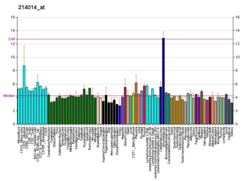Protein-coding gene in the species Homo sapiens
| CDC42EP2 |
|---|
|
| Identifiers |
|---|
| Aliases | CDC42EP2, BORG1, CEP2, CDC42 effector protein 2 |
|---|
| External IDs | OMIM: 606132; MGI: 1929744; HomoloGene: 4933; GeneCards: CDC42EP2; OMA:CDC42EP2 - orthologs |
|---|
| Gene location (Human) |
|---|
 | | Chr. | Chromosome 11 (human)[1] |
|---|
| | Band | 11q13.1 | Start | 65,314,866 bp[1] |
|---|
| End | 65,322,417 bp[1] |
|---|
|
| Gene location (Mouse) |
|---|
 | | Chr. | Chromosome 19 (mouse)[2] |
|---|
| | Band | 19 A|19 4.34 cM | Start | 5,965,664 bp[2] |
|---|
| End | 5,974,844 bp[2] |
|---|
|
| RNA expression pattern |
|---|
| Bgee | | Human | Mouse (ortholog) |
|---|
| Top expressed in | - apex of heart
- gastric mucosa
- blood
- C1 segment
- stromal cell of endometrium
- subcutaneous adipose tissue
- left uterine tube
- gallbladder
- upper lobe of left lung
- left ventricle
|
| | Top expressed in | - ankle
- dermis
- soleus muscle
- secondary oocyte
- granulocyte
- sternocleidomastoid muscle
- interventricular septum
- temporal muscle
- knee joint
- primary oocyte
|
| | More reference expression data |
|
|---|
| BioGPS | 
 | | More reference expression data |
|
|---|
|
| Gene ontology |
|---|
| Molecular function | - protein binding
- GTPase activator activity
- opioid peptide activity
| | Cellular component | - cytoplasm
- microtubule cytoskeleton
- plasma membrane
- membrane
- endomembrane system
- cytoskeleton
- cytosol
- phagocytic vesicle
| | Biological process | - positive regulation of pseudopodium assembly
- positive regulation of actin filament polymerization
- positive regulation of protein-containing complex assembly
- actin cytoskeleton organization
- Rho protein signal transduction
- actin filament organization
- regulation of cell shape
- positive regulation of GTPase activity
- regulation of signaling receptor activity
- cellular response to interferon-gamma
| | Sources:Amigo / QuickGO |
|
| Orthologs |
|---|
| Species | Human | Mouse |
|---|
| Entrez | | |
|---|
| Ensembl | | |
|---|
| UniProt | | |
|---|
| RefSeq (mRNA) | | |
|---|
| RefSeq (protein) | | |
|---|
| Location (UCSC) | Chr 11: 65.31 – 65.32 Mb | Chr 19: 5.97 – 5.97 Mb |
|---|
| PubMed search | [3] | [4] |
|---|
|
| Wikidata |
| View/Edit Human | View/Edit Mouse |
|
Cdc42 effector protein 2 is a protein that in humans is encoded by the CDC42EP2 gene.[5][6][7]
Function
CDC42, a small Rho GTPase, regulates the formation of F-actin-containing structures through its interaction with the downstream effector proteins. The protein encoded by this gene is a member of the Borg family of CDC42 effector proteins. Borg family proteins contain a CRIB (Cdc42/Rac interactive-binding) domain. They bind to, and negatively regulate the function of, CDC42. Coexpression of this protein with dominant negative mutant CDC42 protein in fibroblast was found to induce pseudopodia formation, which suggested a role of this protein in actin filament assembly and cell shape control.[7]
Interactions
CDC42EP2 has been shown to interact with CDC42[5][6] and RHOQ.[5]
References
- ^ a b c GRCh38: Ensembl release 89: ENSG00000149798 – Ensembl, May 2017
- ^ a b c GRCm38: Ensembl release 89: ENSMUSG00000045664 – Ensembl, May 2017
- ^ "Human PubMed Reference:". National Center for Biotechnology Information, U.S. National Library of Medicine.
- ^ "Mouse PubMed Reference:". National Center for Biotechnology Information, U.S. National Library of Medicine.
- ^ a b c Joberty G, Perlungher RR, Macara IG (Oct 1999). "The Borgs, a new family of Cdc42 and TC10 GTPase-interacting proteins". Molecular and Cellular Biology. 19 (10): 6585–97. doi:10.1128/MCB.19.10.6585. PMC 84628. PMID 10490598.
- ^ a b Hirsch DS, Pirone DM, Burbelo PD (Jan 2001). "A new family of Cdc42 effector proteins, CEPs, function in fibroblast and epithelial cell shape changes". The Journal of Biological Chemistry. 276 (2): 875–83. doi:10.1074/jbc.M007039200. PMID 11035016.
- ^ a b "Entrez Gene: CDC42EP2 CDC42 effector protein (Rho GTPase binding) 2".
External links
Further reading
- Guru SC, Agarwal SK, Manickam P, Olufemi SE, Crabtree JS, Weisemann JM, Kester MB, Kim YS, Wang Y, Emmert-Buck MR, Liotta LA, Spiegel AM, Boguski MS, Roe BA, Collins FS, Marx SJ, Burns L, Chandrasekharappa SC (Jul 1997). "A transcript map for the 2.8-Mb region containing the multiple endocrine neoplasia type 1 locus". Genome Research. 7 (7): 725–35. doi:10.1101/gr.7.7.725. PMC 310681. PMID 9253601.
- Burbelo PD, Snow DM, Bahou W, Spiegel S (Aug 1999). "MSE55, a Cdc42 effector protein, induces long cellular extensions in fibroblasts". Proceedings of the National Academy of Sciences of the United States of America. 96 (16): 9083–8. Bibcode:1999PNAS...96.9083B. doi:10.1073/pnas.96.16.9083. PMC 17736. PMID 10430899.
- Joberty G, Perlungher RR, Sheffield PJ, Kinoshita M, Noda M, Haystead T, Macara IG (Oct 2001). "Borg proteins control septin organization and are negatively regulated by Cdc42". Nature Cell Biology. 3 (10): 861–6. doi:10.1038/ncb1001-861. PMID 11584266. S2CID 58805.
- Xue Y, Bi F, Zhang X, Zhang S, Pan Y, Liu N, Shi Y, Yao X, Zheng Y, Fan D (Jun 2006). "Role of Rac1 and Cdc42 in hypoxia induced p53 and von Hippel-Lindau suppression and HIF1alpha activation". International Journal of Cancer. 118 (12): 2965–72. doi:10.1002/ijc.21763. PMID 16395716. S2CID 39137777.


















